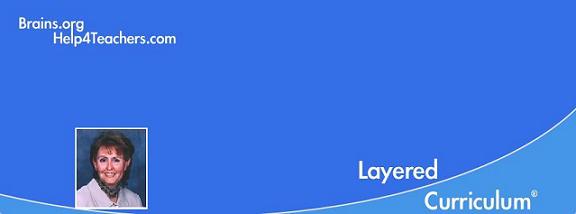__________Layered Curriculum®. . . because every child deserves a special education™_
 |
|
![]() _
_ ![]()
Layered
Curriculum TEXT & WORKBOOK
Set
for only
$43.95
(free shipping in
US)
The 5 Most Important Things to Do in
a Child's First 2 Years.
© Dr Kathie Nunley, 2017The first two years of a child's life may be the most important, in terms of brain development. At no point in his or her life will there be a better opportunity to affect brain structure and function. Every parent and caregiver wants to do what's best, but doesn't often know exactly what that is. It's as simple as remembering that the brain is affected by three things: external stimulation, nutrition and internal chemistry. Here are my top five suggestions for things you can do to give a young child the best start in life.
First, work on language. The number one predictor of a child's success in school is the richness of their vocabulary by the age of 3. So talk to your child. Use your big words. Point things out as you move about the world with her. Real life, face-to-face human interaction. If you and your spouse or partner have different native languages, each of you use your native language when talking to the child. Bi-lingualism is a wonderful asset for brain health.
Secondly, avoid television and other visual electronic media (yes, this includes your smartphone). The reticular activating region of the brain, located in the base of the brain, can be over-stimulated by visual electronics during the first 24 months. This brain region is responsible for attention span. Allow it to develop normally, by avoiding visual electronics.
Number three: Mother's milk is best. The natural fats in breast milk help speed myelination of the central nervous system. Myelin is the fatty covering that develops on nerves as a child develops. The faster the nerves myelinate, the faster information can travel and the more information that can reach the brain from the peripheral nervous sytem. If nursing isn't possible or when you do start your child on other foods, remember to include plenty of natural fats in his diet for good brain health.
Number four: Let your child sleep in total darkness and total quiet. The retina of the eye needs a significant amount of total darkness for proper development. Lights in the nursery, even nightlights, can disrupt proper retina development and increase the liklihood that your son or daughter will be nearsighted. Quiet is important for the brain maintanance that occurs during sleep. Babies need lots and lots of sleep in order to process what's been going on in their wake hours, and let their brains prune and branch appropriately. Backgroud noise from a radio, music maker or television disrupts this brain processing.
Number five: Touch your child. Skin-to-skin contact is critical for healthy nervous system development in a child. Children who are not touched, do not thrive. Make sure you touch your child as much as possible. Face, arms, legs, etc. Insist that all caregivers hold them while feeding. Let your child experience a variety of tactile stimulation as well. Let them feel soft things, furry things, rough sand, cool grass, etc.
A child's brain develops more in the first two years than any other time period. Take advantage of this critical time period by provides lots of human, real world interactions followed by plenty of dark, quiet sleep periods, for the best start in life.
About the Author:
Dr Kathie Nunley is an educational psychologist, researcher and author of several books on parenting and teaching, including A Student's Brain (Brains.org) and the best selling, "Differentiating the High School Classroom" (Corwin Press). She is the developer of the Layered Curriculum® method of instruction and has worked with parents and educators around the world to better structure schools to make brain-friendly environments. In addition, her work has been used by the Boeing Corporation, Family Circle Magazine, the Washington Post, and ABC television.
Email her: Kathie (at) brains.orgCopyright © 1998 - current year by Kathie F. Nunley.
All Rights Reserved.
Layered
Curriculum is a registered trademark developed by
Dr. Kathie F. Nunley.